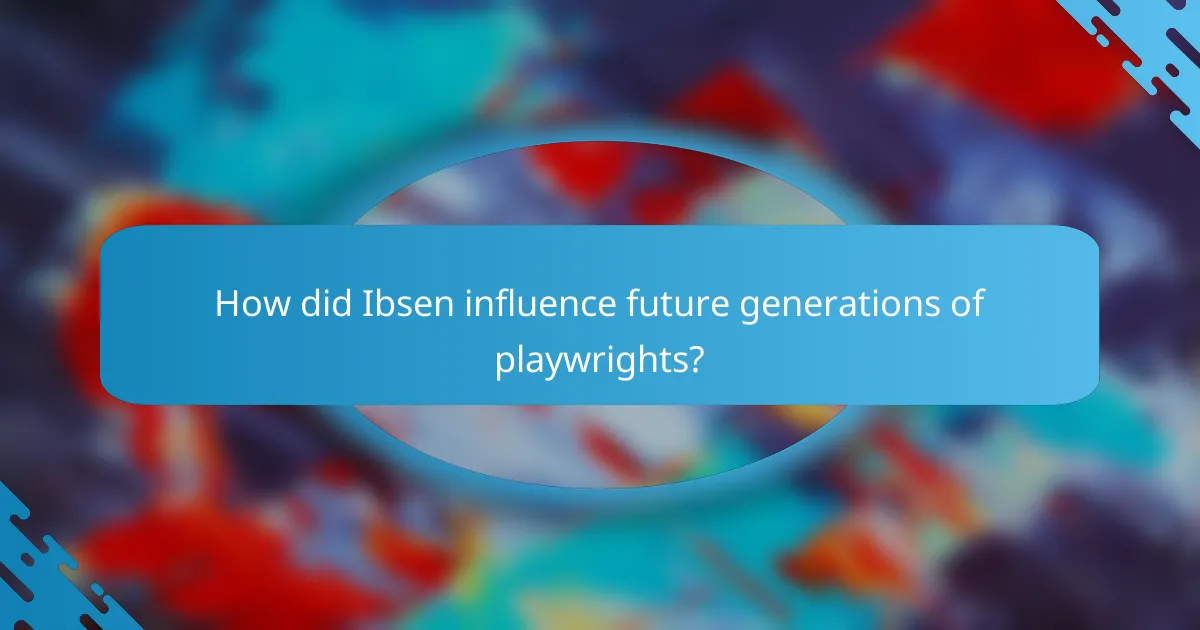Henrik Ibsen is a pivotal figure in 19th century theatre, known for his introduction of realism and exploration of social issues. His plays, such as “A Doll’s House” and “Hedda Gabler,” challenged traditional norms, particularly regarding gender roles and morality. Ibsen’s use of complex characters and realistic dialogue set a new standard for narrative depth, influencing future playwrights like Anton Chekhov and Arthur Miller. His legacy continues to shape modern drama and provoke discussions on societal expectations and personal responsibility. Overall, Ibsen’s contributions have established a lasting impact on both theatre and social discourse.

What is the Legacy of Ibsen in 19th Century Theatre?
Henrik Ibsen’s legacy in 19th century theatre is significant for introducing realism. His works shifted the focus from romanticism to portray everyday life and social issues. Ibsen’s plays often addressed controversial topics like gender roles and morality. “A Doll’s House,” for example, challenged the traditional roles of women in society. His realistic dialogue and complex characters influenced future playwrights. Ibsen’s emphasis on social critique paved the way for modern drama. His impact is evident in the works of later playwrights like Anton Chekhov and August Strindberg. Overall, Ibsen redefined theatrical storytelling, making it more relevant to contemporary audiences.
How did Ibsen’s works redefine realism in theatre?
Ibsen’s works redefined realism in theatre by introducing complex characters and social issues. His plays moved away from melodrama and idealized portrayals. Instead, they presented authentic human experiences and moral dilemmas. Ibsen’s characters often faced societal constraints and personal conflicts. This focus on individual psychology was groundbreaking for the time. His play “A Doll’s House” exemplifies this shift, showcasing a woman’s struggle for identity. Critics noted that Ibsen’s realistic dialogue and settings mirrored everyday life. His influence paved the way for modern drama, emphasizing truth and relevance in storytelling.
What are the key characteristics of realism in Ibsen’s plays?
Realism in Ibsen’s plays is characterized by a focus on everyday life and social issues. His works often depict the struggles of individuals against societal norms. Ibsen emphasizes character development and psychological depth. He uses realistic dialogue to enhance authenticity. The settings are typically ordinary, reflecting real-life environments. Ibsen’s characters often confront moral dilemmas and personal conflicts. His plays challenge traditional values and highlight social injustices. This approach marked a shift in theatre towards more relatable and thought-provoking narratives.
How did Ibsen’s approach differ from previous theatrical traditions?
Ibsen’s approach differed from previous theatrical traditions by introducing realism and focusing on social issues. Unlike romanticism, Ibsen’s plays depicted everyday life and complex characters. He emphasized psychological depth and moral dilemmas. This shift allowed audiences to confront societal norms and personal struggles. Ibsen’s works often featured strong female protagonists challenging societal expectations. His realistic dialogue and settings contrasted with the melodramatic styles of his predecessors. This innovative approach significantly influenced modern theatre and paved the way for future playwrights.
What social issues did Ibsen address in his works?
Ibsen addressed various social issues in his works, including gender roles, individual freedom, and societal norms. He often highlighted the struggles of women in a patriarchal society. In “A Doll’s House,” Ibsen critiques the limitations placed on women and their quest for independence. He also explored the theme of moral hypocrisy in “An Enemy of the People,” where he examined the conflict between truth and public opinion. Additionally, Ibsen tackled issues of class and social responsibility in plays like “Ghosts,” where he revealed the consequences of societal expectations. His works challenged the status quo and encouraged audiences to reflect on their own beliefs and values.
Which specific social issues are prominently featured in Ibsen’s plays?
Ibsen’s plays prominently feature social issues such as gender roles, individual versus society, and moral hypocrisy. His works critique the constraints placed on women, as seen in “A Doll’s House,” where Nora’s struggle for independence highlights societal expectations. Additionally, Ibsen addresses the conflict between personal desires and societal norms, exemplified in “An Enemy of the People,” where Dr. Stockmann confronts the majority’s refusal to accept truth for the sake of public opinion. Moral hypocrisy is also a recurring theme, particularly in “Ghosts,” which explores the consequences of hidden sins and societal judgment. These themes reflect Ibsen’s commitment to realism and social critique in 19th-century theatre.
How did Ibsen’s portrayal of social issues impact public perception?
Ibsen’s portrayal of social issues significantly shifted public perception. His works highlighted societal norms and injustices, challenging the status quo. Plays like “A Doll’s House” exposed gender roles and marital expectations. This prompted audiences to question traditional values. Ibsen’s realistic characters and situations resonated with the public. His focus on individual struggles made social issues more relatable. As a result, Ibsen became a catalyst for social change in the late 19th century. His influence extended beyond theatre, inspiring discussions on women’s rights and morality.

How did Ibsen influence future generations of playwrights?
Henrik Ibsen profoundly influenced future generations of playwrights through his innovative approach to realism and social issues. He introduced complex characters and realistic dialogue, moving away from melodrama. His works often tackled controversial themes such as gender roles, morality, and societal norms. This shift encouraged playwrights to explore deeper psychological and social dimensions in their narratives. Notable playwrights like Anton Chekhov and Arthur Miller cited Ibsen as a major influence. Chekhov adopted Ibsen’s focus on character development and subtlety in storytelling. Miller embraced Ibsen’s themes of personal and social responsibility in his own plays. Ibsen’s legacy laid the groundwork for modern drama, shaping how playwrights address social issues today.
What techniques did Ibsen introduce that are still used today?
Ibsen introduced several techniques that are still used in modern theatre. One significant technique is the use of realistic dialogue. His characters speak in a natural manner, reflecting genuine human interactions. This approach enhances the authenticity of the narrative. Ibsen also employed complex characters with psychological depth. His characters often face moral dilemmas, making them relatable and multidimensional.
Another technique is the focus on social issues. Ibsen’s plays address topics like gender roles and societal norms. This thematic exploration encourages audiences to reflect on contemporary social problems. Additionally, Ibsen utilized the concept of the “well-made play.” This structure includes a clear exposition, rising action, climax, and resolution, which remains a foundational element in playwriting today.
Ibsen’s innovative use of subtext is also notable. His characters often convey underlying emotions and conflicts through their actions and words. This technique adds layers of meaning to the dialogue. Overall, Ibsen’s contributions to realism and character development continue to influence playwrights and theatre practitioners today.
How have Ibsen’s themes been adapted in modern theatre?
Ibsen’s themes have been adapted in modern theatre through contemporary reinterpretations and recontextualizations. Modern productions often explore his focus on social issues and individual struggles in today’s context. For instance, themes of gender roles and societal expectations resonate with current feminist movements. Many directors emphasize psychological depth in characters, reflecting modern understandings of mental health. Adaptations may also shift settings to modern environments, making Ibsen’s critiques of society more relatable. Productions such as “A Doll’s House, Part 2” continue the narrative, presenting characters in new circumstances. This evolution highlights the timelessness of Ibsen’s exploration of human relationships and moral dilemmas. The enduring relevance of his work is evident in how contemporary playwrights draw inspiration from his themes.
Which playwrights cite Ibsen as an influence on their work?
Playwrights such as Eugene O’Neill, Arthur Miller, and Tennessee Williams cite Henrik Ibsen as an influence on their work. O’Neill admired Ibsen’s exploration of complex characters and social issues. Miller acknowledged Ibsen’s impact on modern drama and realism. Williams appreciated Ibsen’s focus on psychological depth and human emotions. These playwrights have incorporated Ibsen’s themes into their own narratives, reflecting his enduring legacy in theatre.
In what ways did Ibsen’s work reflect the societal norms of his time?
Ibsen’s work reflected the societal norms of his time through its exploration of individualism and gender roles. His plays often depicted the struggles of characters against societal expectations. For example, “A Doll’s House” challenged the traditional roles of women in marriage. Ibsen portrayed Nora’s quest for self-identity, which resonated with the growing feminist movement of the late 19th century. Additionally, his focus on moral dilemmas highlighted the hypocrisy of bourgeois society. Plays like “Ghosts” addressed issues such as inheritance and disease, reflecting contemporary concerns. Ibsen’s realistic dialogue and character development mirrored the complexities of human relationships. His works often sparked controversy, indicating their relevance to societal debates of the time. Overall, Ibsen’s plays served as a critique of the constraints imposed by social norms.
How did Ibsen challenge the status quo through his narratives?
Ibsen challenged the status quo through his narratives by exposing societal norms and injustices. He often portrayed strong female characters who defied traditional gender roles. In plays like “A Doll’s House,” Ibsen criticized the limitations placed on women in marriage. His work highlighted issues such as individual freedom and moral integrity. Ibsen’s characters frequently faced moral dilemmas that reflected real-life conflicts. He used realism to depict the struggles of everyday people. This approach encouraged audiences to question their own beliefs and societal structures. His narratives sparked discussions about social change and reform.
What reactions did Ibsen’s plays receive from contemporary audiences?
Ibsen’s plays received mixed reactions from contemporary audiences. Some viewers praised his works for their innovative realism and social critique. Others found his themes controversial and provocative. For instance, “A Doll’s House” faced backlash for its portrayal of marriage and gender roles. Critics argued that it challenged societal norms. Additionally, audiences were often shocked by the frank discussions of taboo subjects. The plays sparked intense debates about morality and individual freedom. Overall, Ibsen’s works significantly influenced the trajectory of modern theatre. His ability to provoke thought and discussion marked a turning point in theatrical history.

What are the lasting impacts of Ibsen’s legacy on theatre and society?
Ibsen’s legacy profoundly impacted theatre and society by introducing realism and addressing social issues. His plays challenged traditional norms and conventions, paving the way for modern drama. Ibsen’s focus on character psychology and moral dilemmas influenced countless playwrights. Works like “A Doll’s House” and “Hedda Gabler” opened discussions on gender roles and societal expectations. This shift encouraged audiences to reflect on their own lives and societal structures. Ibsen’s contributions established a new standard for narrative depth and character complexity. His influence is evident in the works of later playwrights such as Arthur Miller and Tennessee Williams. Overall, Ibsen’s legacy continues to resonate in contemporary theatre and social discourse.
How does Ibsen’s work continue to resonate in today’s world?
Ibsen’s work continues to resonate in today’s world through its exploration of individualism and societal constraints. His plays address themes of gender roles, moral dilemmas, and personal freedom. These issues remain relevant as contemporary society grapples with similar challenges. For instance, plays like “A Doll’s House” highlight the struggle for women’s independence, a topic still pertinent in modern discussions on gender equality. Furthermore, Ibsen’s focus on authenticity and self-discovery encourages audiences to question social norms. His characters often face internal conflicts that mirror the complexities of modern life. This connection to personal and societal issues ensures that Ibsen’s work remains a vital part of cultural discourse today.
What lessons can modern playwrights learn from Ibsen’s approach?
Modern playwrights can learn the importance of realism and social critique from Ibsen’s approach. Ibsen emphasized authentic character development and complex moral dilemmas. His plays often addressed societal issues, such as gender roles and individual freedom. This focus on real-life struggles resonates with contemporary audiences. Additionally, Ibsen’s use of subtext and dialogue creates depth in storytelling. His work encourages playwrights to explore uncomfortable truths. Ibsen’s legacy illustrates that theatre can be a powerful tool for social change. Engaging with these themes can enhance the relevance of modern plays.
What practical insights can be drawn from Ibsen’s exploration of realism and social issues?
Ibsen’s exploration of realism and social issues reveals the complexities of human relationships and societal norms. His works challenge traditional values and highlight the struggles of individuals against oppressive societal structures. For instance, in “A Doll’s House,” Ibsen critiques the limitations placed on women in 19th-century society. This play illustrates the importance of self-identity and personal freedom. Additionally, Ibsen’s characters often confront moral dilemmas, prompting audiences to reflect on their own ethical beliefs. His focus on social issues encourages critical dialogue about gender roles, class, and individual agency. Overall, Ibsen’s realism serves as a mirror to society, urging audiences to examine their own lives and the world around them.
How can contemporary theatre address social issues like Ibsen did?
Contemporary theatre can address social issues by employing realism and critical dialogue, similar to Ibsen’s approach. It can create relatable characters facing societal challenges. This connects audiences to pressing issues like gender inequality, mental health, and social justice. Productions can utilize modern settings and narratives to reflect current realities. Interactive elements, such as audience participation, can deepen engagement. Additionally, collaborations with activists can enhance authenticity and urgency. By integrating multimedia, contemporary theatre can reach diverse audiences effectively. Historical context shows Ibsen’s works sparked discussions; modern theatre can continue this legacy.
What strategies can be employed to engage audiences with social themes in theatre?
Engaging audiences with social themes in theatre can be achieved through several effective strategies. First, incorporating relatable characters allows audiences to connect emotionally with the narrative. This connection enhances empathy towards social issues presented in the play. Second, using contemporary settings can make the themes more relevant to modern audiences. This relevance encourages reflection on current societal challenges. Third, interactive elements, such as audience participation, can deepen engagement. This participation fosters a sense of involvement in the social dialogue. Fourth, employing multimedia elements can enhance storytelling. This approach can visually and audibly underscore the themes being explored. Fifth, hosting post-performance discussions can provide context and encourage dialogue. This dialogue can further illuminate the social themes addressed in the production. Lastly, collaborating with community organizations can create partnerships that amplify the message. These partnerships can also attract diverse audiences, broadening the impact of the social themes.
The main entity of the article is Henrik Ibsen, a pivotal figure in 19th century theatre known for his contributions to realism and social critique. The article explores Ibsen’s legacy, highlighting how his works shifted theatrical focus from romanticism to everyday life and social issues, particularly gender roles and morality. Key characteristics of Ibsen’s realism, such as complex characters and authentic dialogue, are examined alongside the social issues he addressed, including individual freedom and moral hypocrisy. The article also discusses Ibsen’s influence on future playwrights and the lasting impact of his themes on contemporary theatre and society.



